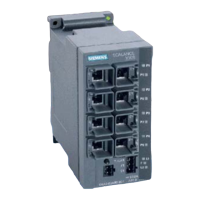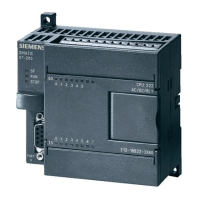Using the Text Display Wizard to Configure the S7-200 CPU for Your Text Display (TD) Device
4.5 Configuring the Alarms
Text Display (TD) User Manual
System Manual, 08/2008, A5E00765548-03
89
Determining the Type of Operator Interaction for an Alarm
The Text Display wizard allows you to determine the type interaction required by the
operator for an alarm. If the user screens are set as the default display mode for the TD
device and an alarm is enabled, an alarm indicator will begin to flash on the TD display. The
indicator is large if there is an alarm enabled that requires acknowledgement. The indicator
will be small if the alarms do not require acknowledgement. The user can switch to the alarm
display to view the alarms.
The alarm display will show one or more alarms in priority order. An UP or DOWN arrow in
the right-most character position indicates more alarms are active, but not visible on the
display. The operator can press either the UP or the DOWN arrow key to scroll through the
other enabled alarms.
The operator can edit or accept variable values by pressing the ENTER key. The TD device
will write the updated variable value to the CPU and set the edit notification bit for that
variable when the operator presses the ENTER key. The TD device then moves the cursor
to the next editable variable. Pressing ENTER for the last editable variable of an alarm writes
this last value to the S7-200 CPU and the TD device then resets the alarm enable bit. For
more information on editing variables, see Editing a Variable that is Embedded in an Alarm
or a Screen in Chapter 5.
Every alarm falls into one of four possible alarm acknowledgement and editing types. This
section explains specifically how each alarm type is handled by the TD device. The four
alarm types follow:
● No acknowledgement required, no edits allowed
● Acknowledgement required, no edits allowed
● No acknowledgement required, edits allowed
● Acknowledgement required, edits allowed
No Acknowledgement Required, No Edits Allowed
In this combination of no acknowledgement required and no edits allowed, the TD device
simply displays the alarm. The ENTER key has no function since there are no editable
variables within the alarm. The alarm may contain variables that are updated at the update
rate of the TD device. This type of alarm is replaced on the display if a higher priority alarm is
enabled by the S7-200 CPU. The operator can either press the UP or the DOWN arrow key
to scroll to other alarms or press ESC to return to the menus.
The TD device does not clear the corresponding alarm-enable bit in the S7-200 CPU.
Acknowledgement Required, No Edits Allowed
In this combination of acknowledgement required and no edits allowed, the TD device
displays the alarm and makes the entire alarm flash (blink) until the operator presses ENTER
to acknowledge the alarm. Variable values are updated from the S7-200 CPU at the normal
update rate while the alarm is flashing.
When the operator presses ENTER, the TD device:
● Sets the acknowledgement-notification bit for this alarm.
● Clears the alarm-enable bit for this alarm. This causes the alarm to be removed from the
displ
ay on the next update cycle.

